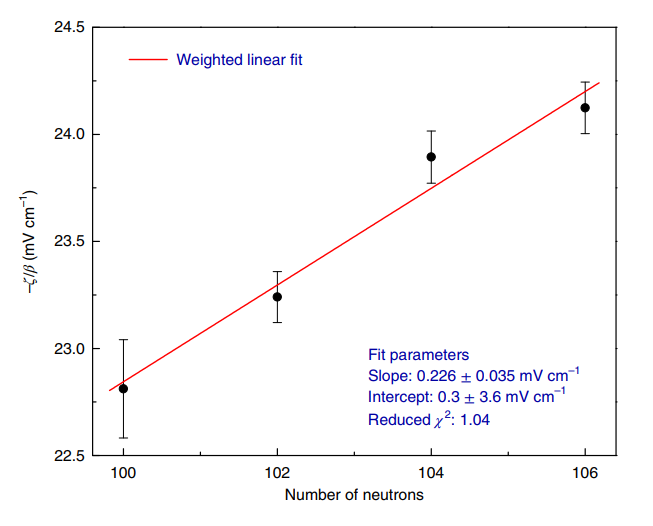Atomic parity violation (APV) experiments offer the opportunity to study the weak interactions at low-energy scales, providing valuable information about the Standard Model and nuclear physics. Owing to its high atomic mass, the strong mixing by the weak interaction of two opposite parity eigenstates, as well as the availability of many stable isotopes, ytterbium (Yb) is a particularly good candidate for investigating APV effects. The high measurement precision that can be, in principle, achieved, brings within reach the possibility to detect the nuclear anapole moment of the Yb nucleus as well as to probe the variation of neutron skin among the different isotopes of this element.
With the use of a sensitive atomic beam apparatus (Fig. 1), our team has recently completed a series of measurements of the APV effect on a chain of nuclear-spin-zero Yb isotopes (with mass A=170, 172, 174, 176). The single-isotope precision in those measurements is at the 0.5% level, allowing for a clear observation of the isotopic variation of the APV effect (Fig. 2). This variation was seen directly for the first time and was found to be consistent with the prediction of the Standard Model of particle physics. The work was reported in Nature Physics in 2019.
Several apparatus sensitivity improvements are underway. With those improvements, the sensitivity will be boosted by an order of magnitude (i.e. sub 0.1%). This is expected to enable observations of the Yb nucleus anapole moment, as well as the study of neutron distributions in the Yb nuclei.

Fig. 1: Yb atomic beam apparatus operating the Helmholtz Institute Mainz

Fig. 2: Isotopic variation of the APV effect, measured in four Yb isotopes with zero nuclear spin.
References:
- D. R. Dounas-Frazer, K. Tsigutkin, A. Family, and D. Budker, Measurement of dynamic Stark polarizabilities by analyzing spectral lineshapes of forbidden transitions, Phys. Rev. A 82(6), 062507 (2010) (arXiv:1009.5952)
- K. Tsigutkin, D. Dounas-Frazer, A. Family, J. E. Stalnaker, V. V. Yashchuk, and D. Budker, Parity violation in atomic ytterbium: experimental sensitivity and systematics, Phys. Rev. A 81(3), 032114 (2010) (arXiv:1001.0587)
- K. Tsigutkin, D. Dounas-Frazer, A. Family, J. E. Stalnaker, V. V. Yashchuk, D. Budker, Observation of a Large Atomic Parity Violation Effect in Ytterbium, Phys. Rev. Lett. 103, 071601 (2009). (arXiv:0906.3039)
- K. Tsigutkin, J. E. Stalnaker, D. Budker, S. J. Freedman, and V. V. Yashchuk, Towards measuring nuclear-spin-dependent and isotopic-chain atomic parity violation in Ytterbium, in From Parity Violation to Hadronic Structure and more…, Ed. by K. de Jager et al, Springer 2007. (physics/0608314)
- J. E. Stalnaker, D. Budker, S. J. Freedman, J. S. Guzman, S. M. Rochester, and V. V. Yashchuk, Dynamic Stark effect and forbidden-transition spectral lineshapes, Phys. Rev. A 73, 043416 (2006). (physics/0512111)
- J. E. Stalnaker, D. Budker, D. P. DeMille, S. J. Freedman, and V.V. Yashchuk, Experimental determination of the 6s2 1S0->5d6s3D1magnetic-dipole transition amplitude in atomic ytterbium, Phys. Rev. A 65 (2002), 031403. (physics/0201026)
- D. Budker and J. E. Stalnaker, Magnetoelectric Jones dichroism in atoms Phys. Rev. Lett., 91(26), 263901 (2003). (physics/0302096)
- D.F. Kimball, D. Clyde, D. Budker, D. DeMille, S.J. Freedman, S. Rochester, J.E. Stalnaker, and M. Zolotorev, Collisional Perturbation of States in Atomic Ytterbium by Helium and Neon, Phys. Rev. A 60(2), 1103 (1999).
- C.J. Bowers, D. Budker, D. DeMille, S.J. Freedman, G.Gwinner, and J.E. Stalnaker, Experimental investigation of the 6s2 1S0→5d6s3D1,2 forbidden transitions in atomic ytterbium, Phys. Rev. A 59(5), 3513 (1999).
- C.J. Bowers, D. Budker, E.D. Commins, D. DeMille, S.J. Freedman, A.-T. Nguyen, S.-Q. Shang, and M. Zolotorev, Experimental investigation of excited state lifetimes in atomic ytterbium,Phys. Rev. A 53(5), 3103-9 (1996).
- B. DeBoo, D. F. Kimball, C.-H. Li, and D. Budker, Multichannel Conical Emission and Parametric and Nonparametric Nonlinear Processes in Yb vapor, JOSA B, 18(5), 639-645 (2001).
- D.F. Kimball, Parity-nonconserving optical rotation on the 6s6p 3P0→6s6p 1P1 transition in atomic ytterbium, Phys. Rev. A 63, 052113 (2001).
